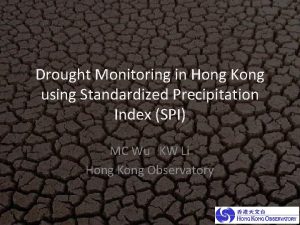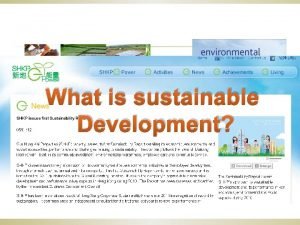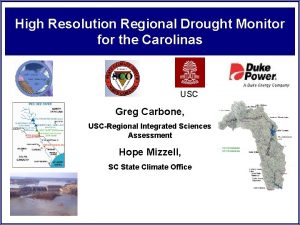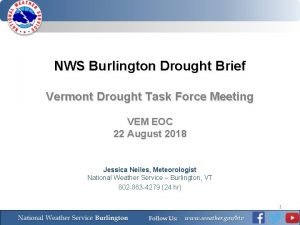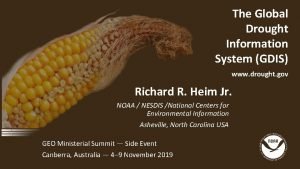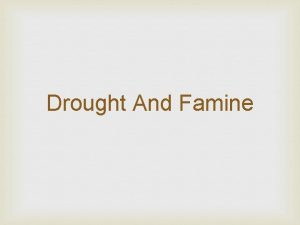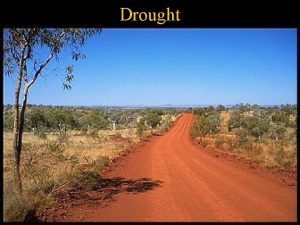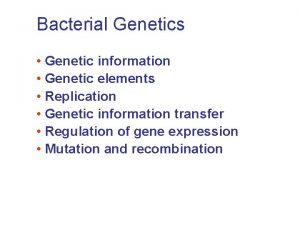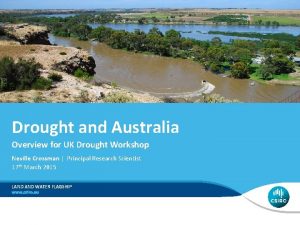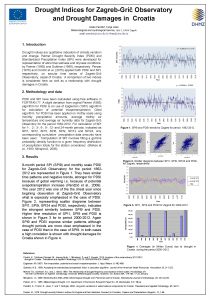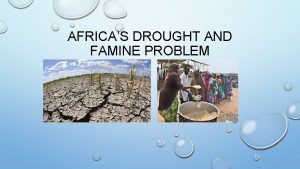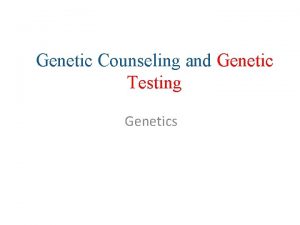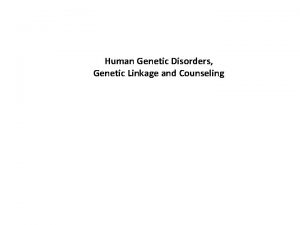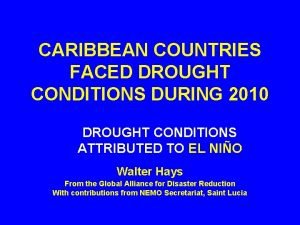SOME ELEMENTS TO IMPROVE AND EXPLORE GENETIC DROUGHT
















- Slides: 16

SOME ELEMENTS TO IMPROVE AND EXPLORE GENETIC DROUGHT RESISTANCE Abel Muñoz-Orozco Genetica IREGEP, Colegio de Postgraduados, México Francisco Muñoz-Arriola and D. P. Lettenmaier Department of Civil and Environmental Engineering, University of Washington, USA 5 -9 of October 2008 Join Annual Meeting ASA-CSSA-SSSA Houston, TX. USA

Outline • • Motivation and General Concepts Examples of Drought Resistance Models Modeling Agricultural Drought – VIC • Further work

Motivation • In micro regions (ecological niches) most of the patterns of crop’s genetic resistance to drought and other adverse factors are unknown • These patterns are important to study crop’s genetic resistance in the context of climate change SOME ABIOTIC ADVERSE FACTORS CONFRONTED IN MEXICO • Serdán, Puebla example: Great Drought of Winter, Intra Summer drought, and frost conditions; with or without residual humidity. • Huetamo, Michoacán example: low rainfall and high temperatures, with out residual humedity • In the numerous micro regions there a wide diversity of combinations of abiotic adverse factors and patterns of genetic resistance


GENERAL CONCEPTS • • • Drought is a period with low rainfall Drought Resistance, is the energy accumulated by a variety against drought Effects of drought are modified (not the drought) mainly by elements as t, T, S, ψa, Ll, D, O, Sp, A + I – – – – – t, duration of drought T, temperature S, different elements of the soil Ψa, water potential of the air Ll, amount of rainfall D, its distribution O, ontogenetic stage of the plant Sp, species A, pre-conditioning I, an interactión of the genetic elements with environmental elements Muñoz Orozco, A. (2004). Conceptos fundamentales para evaluar la resistencia a sequia. XI International Conference on Rainwater Catchment System (Colegio de Posgraduados), pag. 518 -522

EXAMPLES OF DROUGHT RESISTANCE CARACTERISTICS DETECTED • In peanut (Arachis hypogaea L. ): flowering plasticity; when there is Drought, flowering reduces and renews when raifall resumes • In sorgo (Sorhum vulgare Pers. ): heat tolerance; the panicle produces grain and the leaves do not dry during high temperatures • In maize (Zea mays L. ): tolerance; when there is drought, growing is reduced and renewed when rainfall reasumes. It is asociated to stomatal hipersensitivity, stomatal closure at higher leaf-water potentials. • The evaluation of drought resistance is based in the model one Muñoz Orozco et al. , (1983). Transpiracion, fotosintesis, eficiencia en uso de agua y potencial hídrico en maices resistentes a sequia y heladas. Agrociencia. 51, pag. 115 -153

MODEL ONE TO EVALUATE DROUGHT RESISTANCE Y=G+D+G*D Y, total variation G, variation of genotypes (estimates of genetic generic effects such as those expressed under drought or wet conditions) D, variation of drought levels (or through locations) G*D interaction of G by D (estimates the specific effects to drought, which are expressed only under drought conditions) Muñoz Orozco, A. (1990). Modelo matématico para evaluar la resistencia a sequia: casos uno a seis. Evolucion Biológica (ASIBE), pag. 93 -106.

ONTOGENETIC DROUGHT RESISTANCE AND PHYLOGENETIC DROUGHT RESISTANCE R O Y 1 Early R S G Fl Early S O Ontogenetic drought resistance RF Y 2 Intermediarte R S G Fl S Intermediate O Ontogenetic drought resistance Y 3 S G Fl Late S Phylogenetic drought resistance • Ontogenetic drought resistance (D ) or resistance through ontogenetic stages of a variety, such as early, intermediate or late varieties • Phylogenetic drought resistance (RP) or resistance among averages of varieties of different precocity Drought resistance (Energy accumulated against drought conditions) O Ontogenetic drought resistance Late G=GERMINATION F=FLOWERING S=SEED FORMATION

MODEL TWO TO EVALUATE DROUGHT RESISTANCE • Y=RO+RP+RO*RP Where Y, total variation RO, ontegenetic drought resistance or resistance through the ontogenetic stages RP, phylogenetic drought resistance or resistance among averages of varieties RO*RP, interactión of RO by RP • These concepts contribute to better understand the drought resistance of the maize varietal patterns in the mexican micro regions. • These varietal patterns are clusters of early, inermediate, and late varieties adapted to different environmental conditions of the micro regions Muñoz Orozco, A. (1997). Model 2 to select for drought tolerance. Developing drought and low Ntolerant maize. (CIMMYT), pag 541 -543

Maize varietal pattern from mexican central high valleys, the white and cream color grain variety is late, the yellow one intermediate and the blue one early

VIC Model • Available Indices – Palmer Drought Index – Standardized Precipitation Index – Surface Water Supply Index • Proposed Method – Use of Hydrological Models to create continuous spatiotemporal patterns of drought-linked variables – SM and RO Percentiles relative to the climatology (1960 -1999) – Allow monitoring and forecast

Short- and Long-term Drought predictions Predicted Soil Moisture Percentile using the UW Seasonal Hydrological Forecast System Long-term hydrological assessments based temperature increments Huetamo Serdan Short-term hydrological predictions based on ensemble techniques

Assemble to rain fall and temperatures conditions of the maize varietal pattern from Mexican central high valleys Early variety Intermediate variety Late variety Use of hydrological modeling to predict short- and long-term agricultural drought integrated into the Genetic Drought Resistance Modeling Framework

Acknowledgments • Shraddhanand Shukla, UW • Alan Hamlet, UW

Yield or Accumulated Energy D 0 G 1 0 +g -g G 2 -d +g*d -g*d D 1 0 D 1 Drought Level +d

Yield or Accumulated Energy D 1 D 0 D 1 6 cases (P=Yield) 1) PG 1=PG 2 ( in D 0); PG 1>PG 2 (D 1) 2) PG 1>PG 2 ( in D 0); PG 1=PG 2 (D 1) D 0 3) PG 1>PG 2 ( in D 0) = PG 1>PG 2 (D 1) D 4) 1 PG 1=PG 2 ( in D 0) > DPG 1=PG 2 (D 1) 0 5) PG 1=PG 2 ( in D 0) < PG 1=PG 2 (D 1) 6) PG 1>PG 2 ( in D 0) ; PG 1<PG 2 (D 1) 7) Plus n intermediate cases D 1 D 0 D 1
 What is specation
What is specation Genetic programming vs genetic algorithm
Genetic programming vs genetic algorithm Genetic programming vs genetic algorithm
Genetic programming vs genetic algorithm What is the difference between genetic drift and gene flow
What is the difference between genetic drift and gene flow Genetic drift vs genetic flow
Genetic drift vs genetic flow Drought and desertification
Drought and desertification Drought sentence
Drought sentence Types of drought
Types of drought Bibliography of drought in south africa
Bibliography of drought in south africa Aleph toolbox
Aleph toolbox Drought presentation
Drought presentation Anasazi drought
Anasazi drought Mrsac maharashtra gov in jalyukt
Mrsac maharashtra gov in jalyukt Vermont drought monitor
Vermont drought monitor Utah drought map
Utah drought map Drought stopper system
Drought stopper system World, drought monitor
World, drought monitor







